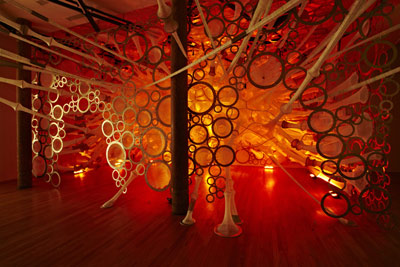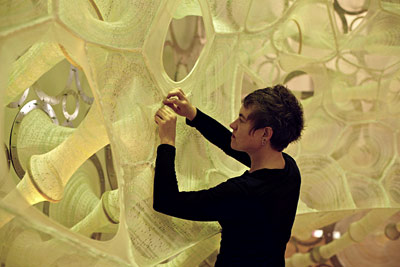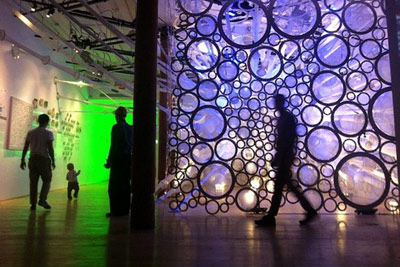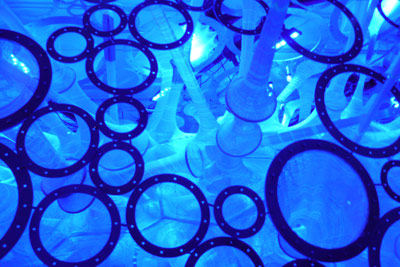Jenny Sabin designs innovative textile pavilion for Nike
By Sherrie Negrea




Can a building be constructed from thread? Assistant professor of architecture Jenny Sabin demonstrates the potential of soft textile-based architecture with a pavilion she has designed using photo-luminescent, solar-active and reflective threads, now open to the public in New York City.
The project was commissioned by Nike Inc. as part of the release of its Flyknit Collection, a new technology that uses machine-knitted fabric and eliminates many toxic glues from the manufacturing process. Nike began unveiling its Flyknit athletic shoes in April.
To showcase its new line of footwear, Nike launched an initiative called the Flyknit Collective and selected six architects, designers and artists to create works inspired by the product's innovative design. The Flyknit Collective is a platform for creative innovators worldwide to generate dialog around and interact with the fundamental design principles of performance, lightness, formfitting and sustainability -- ultimately converting these abstract benefits into practical, physical structures and spaces that inspire the communities around them in transformative ways. Besides New York City, the projects will be located in Shanghai, London, Milan, Rio de Janeiro and Tokyo.
"Even though Nike is working at the scale of a shoe, the same principles apply at the scale of a building, and that's what I'm interested in probing," Sabin says. "I'm interested in how the simplicity of knitting is coupled with the dynamics and complexity of the human body. One of the questions that we've had is: Could we knit, braid and weave buildings?"
Her myThread Pavilion in Manhattan provides an answer. Made from threads that change color in the sun or glow at night, the 500- to 600-square-foot pavilion offers a range of sports activities for the public until it is dismantled in November. The pavilion opened Sept. 15 and is open to the public noon-7 p.m. Thursday-Sunday, through Nov. 4 at Nike Bowery Stadium, 276 Bowery.
"In a larger sense the pavilion is really about celebrating advanced material products that are inspired by the dynamics of the human body and advancements in textile-based technologies," Sabin says. "The pavilion will be a show piece that people will get excited about, while the programs in the pavilion will be rooted in sports activities. It will feature novel formal expressions that adapt to changes in the environment and increase building performance through formfitting and lightweight structures."
Sabin, whose research investigates the intersection of architecture and science, has been working with graduate students James Blair, M.Arch. '13, and Simin Wang, M.Arch. '13, on the project. This summer, they developed digital models and drawings for the design at Sabin's architecture studio in Philadelphia. Sabin has also led two workshops for the Flyknit Collective at Bowery Stadium in New York. The first workshop focused on collecting data from people who run in Manhattan and connecting that information to the knitting process. The second applied specific materials to the data and created prototypes using a 3-D printer and a knitting machine.
Teams working on projects for the other cities have developed different interpretations of the Flyknit technology. The architect designing the project for Shanghai, Arthur Huang, B.Arch. '01, is the co-founder and managing director of Miniwiz, a Taiwanese company that uses recycled material to develop materials incorporated into buildings and consumer products.
Sherrie Negrea is a freelance writer.
Get Cornell news delivered right to your inbox.
Subscribe